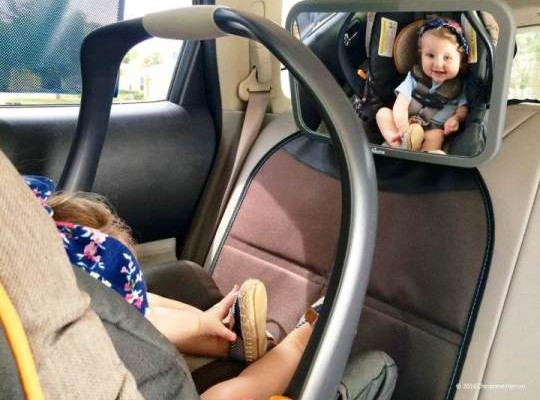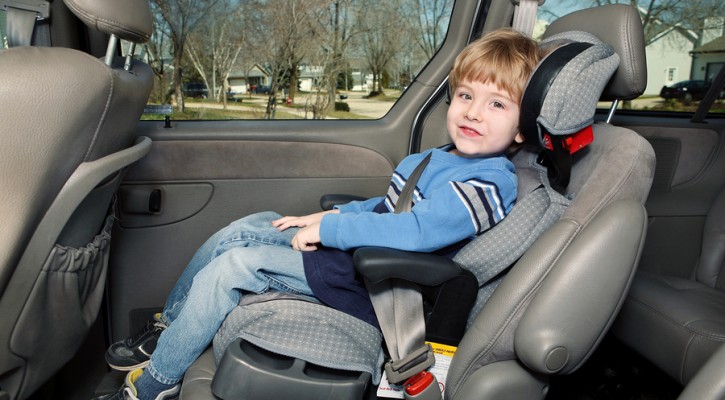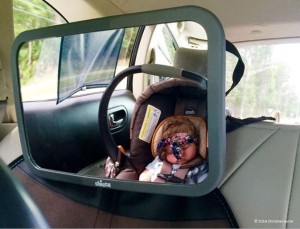Tag Archive: child passengers

Baby Mirror: Safe Or Distracting?
May 17, 2016
A baby mirror to monitor the baby in the back seat of the car has become a popular gift at baby showers over the last few years and for good reason. The safest place for a baby in a car is securely fastened into a rear-facing infant seat mounted in the rear seat of the vehicle. That makes it difficult for the parents to see the child so, a forward facing baby mirror mounted over the infant safety seat is the best compromise. However, the question comes up, is a baby mirror a good safety tool or just another distraction added to all the other distractions that make driving so dangerous today? The answer is; it all depends on how it’s used by the driver.
Distraction:
Parents of a newborn baby love watching this incredible miracle that they’ve created but you can watch too much. If a driver is tempted to watch for the baby’s reaction while talking to her, he or she can take too much time from the critically important job of keeping his or her eyes on the road.
Studies have shown that most traffic crashes happen within three seconds of a driver distraction. If you take your eyes off the road to look at your baby for just two seconds while driving at 45 mph, your vehicle will travel over 130 feet. A lot can happen in that time and distance. If an emergency should happen in that space, it’ll take, on average, an additional 84 feet to bring your car to a stop. Good thing you have a good, safe baby seat.
To protect that precious bundle of joy, the driver needs to keep his or her eyes on the road at all times. Give the baby the same amount of attention that you would give to other vehicles in your rearview mirror. Just a quick glance every 10 to 15 seconds just to make sure everything’s OK. Make sure that your rearview mirror is positioned on the road behind and not aimed mostly at the baby mirror.
Safety Tool:
As long as you’re not allowing the baby mirror to be a distraction, it can be an excellent safety tool.
Babies are constantly exploring and learning new things. One thing they tend to learn, as early as 12 months, is that they’re capable of unbuckling their seat harness and crawling out of their child seat. One study showed that 75% of children who discover they can unbuckle their seatbelt were ages three and under. Once they make this miraculous discovery, it can be very hard to keep them buckled up. Checking to ensure that your child is safely buckled in is one of the best reasons for investing in a baby mirror. If your child is getting out of his or her seat, don’t panic and never try to deal with it from the driver’s seat while the car is in motion. Pull as far off the side of the road as possible, then get out and deal with the situation.
Remember that the safest place to interact with your child is at home. While you’re driving, pay attention to the road so that you can both get home safely.

Child Passenger Safety Week Sept. 14-20
September 15, 2014
This is National Child Passenger Safety Week and it’s a good time to remind parents or those who care for children, about the proper way to care for a child while driving. When it comes to child safety seats, one size doesn’t fit all and it’s important to understand how to choose and install the proper child seat according to your child’s age.
According to a survey by the National Highway Transportation Safety Administration (NHTSA), these are the most common mistakes made by parents when installing and using child safety seats and booster seats:
- Wrong harness slot used – The harness straps used to hold the child in the car seat were positioned either too low or too high;
- Harness chest clip positioned over the abdomen rather than the chest or not used at all;
- Loose car seat installation – The restraint system moved more than two inches side-to-side or front to back; anything more than one inch is too much.
- Loose harness – More than two inches of total slack between the child and the harness strap; there should be no slack.
- Seat belt placement was wrong – Lap belt resting over the stomach and/or shoulder belt on the child’s neck or face.
Both NHTSA and SafeKids recommend the following steps listed on the Safe Kids downloadable checklist:
- Right Seat. Check the label on your car seat to make sure it’s appropriate for your child’s age, weight and height.
- Right Place. Kids are VIPs, just ask them. We know all VIPs ride in the back seat, so keep all children in the back seat until they are 13. Doing this, along with correctly using the appropriate child restraints, greatly reduces the risk of injury.
- Right Direction. You want to keep your child in a rear-facing car seat for as long as possible. When he or she outgrows the seat, move your child to a forward-facing car seat. Make sure to attach the top tether after you tighten and lock the seat belt or lower anchors.
- Inch Test. Once your car seat is installed, give it a good shake at the base. Can you move it more than an inch side to side or front to back? A properly installed seat will not move more than an inch.
- Pinch Test. Make sure the harness is tightly buckled and coming from the correct slots (check manual). Now, with the chest clip placed at armpit level, pinch the strap at your child’s shoulder. If you are unable to pinch any excess webbing, you’re good to go.
Many parents don’t realize that child safety seats have an expiration date. The plastic and synthetic materials used to make the seat’s body and straps can break down over time when exposed to the high heat and sunshine in a parked car. It’s not a good idea to use a hand-me-down car seat for younger children.
There are several good websites that provide information on the proper selection, installation and care of child safety seats. For information about:
- Advice on child safety in and around cars, visit the Insurance Institute for Highway Safety (IIHS): http://www.iihs.org/iihs/brochures/keeping-children-safe
- IIHS ratings on booster seats, visit: http://www.iihs.org/iihs/ratings/child-boosters
- Where to find a car safety seat inspection station near you, visit: http://www.seatcheck.org/
- Child safety seat laws in your state: http://www.iihs.org/iihs/topics/laws/safetybeltuse?topicName=child-safety

